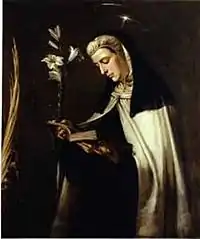tertiary
See also: Tertiary
English
WOTD – 29 July 2017
| Previous: | secondary |
|---|---|
| Next: | quaternary |
Etymology

The chapel of Peterhouse, Cambridge, seen across the Old Court. Founded in 1284, Peterhouse is the oldest of the colleges of the University of Cambridge in Cambridge, UK. Universities provide tertiary education (sense 1), after primary and secondary education.

A ball-and-stick model of trimethylamine, which is a tertiary amine (sense 2) as it consists of a nitrogen atom (blue) linked to three methyl groups (black and grey)
Borrowed from the Latin tertiārius (“of the third part or rank”), from tertius (“third”) + -ārius (whence the English suffix -ary); compare the French tertiaire.
Pronunciation
- (Received Pronunciation) IPA(key): /ˈtɜː.ʃi.ə.ɹiː/
- (General American) IPA(key): /ˈtɝ.ʃi.æ.ɹi/, /ˈtɝ.ʃə.ɹi/
Audio (GA) (file) Audio (AU) (file) - Hyphenation: ter‧ti‧a‧ry
Adjective
tertiary (not comparable)
- Of third rank or order; subsequent.
- 1780, “Art. XIV. Observations sur la Formation des Montagnes et les Changemens arrivés au Globe, &c.—Observations on the Formation of Mountains, and the Changes and Revolutions which have taken place in our Globe; composed with a View to the Natural History of M. de Buffon. By P. S. Pallas, Member of the Academy of Petersburg, in 12mo. pp. 90. Price 24 Livres. Printed at Paris. 1779.”, in The Monthly Review; or, Literary Journal, volume LXI, London: Printed for R. Griffiths, and sold by T. Becket, corner of the Adelphi, Strand, OCLC 427247466, page 550:
- Beſides theſe primordial mountains, M. [P[eter] S[imon]] Pallas maintains, that there are others of a more recent origin. These he calls ſecondary and tertiary: […] the latter ariſe from the wrecks and contents of the ſea, raiſed and tranſported by volcanic eruptions and conſequent inundations.
- 1831, [Mary Shelley], chapter 2, in Frankenstein; or, The Modern Prometheus (Standard Novels; no. 9), rev. and corr. edition, London: Henry Colburn and Richard Bentley, New Burlington Street; Edinburgh: Bell and Bradfute; Dublin: Cumming, →OCLC; republished as Mary Shelley, Frankenstein, New York, N.Y.: Bantam Books, November 1991, →ISBN, page 25:
- An untaught peasant beheld the elements around him and was acquainted with their practical uses. The most learned philosopher knew little more. He had partially unveiled the face of Nature, but her immortal lineaments were still a wonder and a mystery. He might dissect, anatomize, and give names; but, not to speak of a final cause, causes in their secondary and tertiary grades were utterly unknown to him.
- 1854 May, “Reviews and Literary Notices: Education, Best Promoted by Perfect Freedom, Not by State Endowments. With Official Returns of Education. By Edward Baines. 8vo. 47pp. John Snow.”, in The Wesleyan Methodist Association Magazine, volume XVII, London: Association Book-room, 5, Horseshoe Court, Ludgate Hill, OCLC 909279633, page 231:
- If artistic and industrial education, if Mechanics Institutions, Colleges, and all the establishments of secondary and tertiary education, are to be taken under Government management, the objections stated above would be greatly aggravated and multiplied.
-
- (chemistry) Possessing some quality in the third degree; especially having been subjected to the substitution of three atoms or radicals.
- a tertiary alcohol, amine, or salt
- 1873 January 3, A[ugust] W[ilhelm von] Hofmann, “Synthesis of Aromatic Monoamines by Intramolecular Atomic Interchange”, in William Crookes, editor, The Chemical News and Journal of Physical Science: A Journal of Practical Chemistry in All Its Applications to Pharmacy, Arts, and Manufactures, volume XXVII, number 684, London: Henry Gillman, Boy Court, Ludgate Hill, E.C., OCLC 802528027, page 1, column 1:
- If, on the other hand, we remember that a tertiary monoamine, such as must be formed by the final methylation of the ammonia fragment in aniline when submitted to the action of an alcohol chloride, is invariably converted into an ammonium compound it must appear rather strange that in the process above alluded to only tertiary, and never any quartery bases are observed.
- (ornithology) Of quills: growing on the innermost joint of a bird's wing; tertial.
- 1993, Ralph E. Mirarchi, “Growth, Maturation, and Molt”, in Thomas S. Baskett, Mark W. Sayre, Roy E. Tomlinson, and Ralph E. Mirarchi, editors, Ecology and Management of the Mourning Dove (Wildlife Management Institute Book), Harrisburg, Pa.: Stackpole Books, →ISBN, page 141:
- The primary, secondary, and tertiary wing feathers (remiges) of adult mourning doves are shed and replaced yearly in an orderly sequence, so flight is possible during molt. […] Little is known about the shedding sequence of the secondary or tertiary feathers or the related coverts. If it is similar to that of passerines, however, loss of the outermost tertiary feather occurs coincident with loss of the fifth or sixth primary […]. The molt then would continue sequentially until the last or innermost tertiary was shed and replaced.
-
Coordinate terms
Derived terms
- methyl tertiary butyl ether
- nontertiary
- pretertiary
- tertiarily
- tertiarization
- tertiary alcohol
- tertiary amine
- tertiary amyl
- tertiary butyl
- tertiary butylhydroquinone
- tertiary care
- tertiary colour
- tertiary education
- tertiary healthcare
- tertiary industry
- tertiary-level education
- tertiary phosphine
- tertiary sector
- tertiary source
- tertiary structure
- tertiary work
Translations
of third rank or order
See also
Noun

An anonymous 18th- to 19th-century portrait of Jeanne de Toulouse, regarded by some as the founder of the Third Order of Our Lady of Mount Carmel or Lay Carmelites (sense 2). She is revered at Saint-Étienne Cathedral in Saint-Étienne, France.
tertiary (plural tertiaries)
- Any item considered to be of third order.
- 1958 August, Ellis W. Hauser; H. Fred Arle, “Growth Habits”, in Johnson Grass as a Weed (Farmers’ Bulletin; no. 1537), Washington, D.C.: United States Department of Agriculture, OCLC 777886428, page 4, column2:
- The primary rhizomes usually die during the growing season. The tertiaries and secondaries, however, live through the winter and become primary rhizomes the following year.
- 1995 April, Donald [E.] Campbell, “Hydraulics of Canal Regulation and Types of Control Structures”, in Design and Operation of Smallholder Irrigation in South Asia (World Bank Technical Paper (Irrigation and Drainage Series); no. 256), Washington, D.C.: The World Bank, →ISBN, ISSN 0253-7494, page 41:
- The options available for distribution of water during times of reduced supply or demand are the following: […] (b) To reduce the rate of flow in the primary canal (still maintaining continuous flow in it) and to supply full flow in rotation to secondaries and their tertiaries; (c) to reduce the rate of flow in both primary and secondary canals, and to supply full flow in rotation to tertiaries; […]
- 1997 April, E[dward] B. Rice, “Influence of O&M Performance on Agro-economic Impacts”, in Paddy Irrigation and Water Management in Southeast Asia, Washington, D.C.: The World Bank, →ISBN, ISSN 1011-0984, page 49:
- There is no evidence that irrigators fail to keep their supply canals (tertiaries, watercourses, ditches) open when they need water.
-
- A tertiary colour.
- 1817 August 16, Thomas Hargreaves, “XXI. On the Work Entitled ‘Chromatics;’ or, An Essay on the Analogy and Harmony of Colours. By Mr. T. Hargreaves.”, in Alexander Tilloch, editor, The Philosophical Magazine and Journal: Comprehending the Various Branches of Science, the Liberal and Fine Arts, Geology, Agriculture, Manufactures and Commerce, volume 50, number 232, London: Printed by Richard and Arthur Taylor, Shoe Lane […], OCLC 11640955, page 128:
- My principal objection is against the compound or derivative tints, given under the denominations of secondaries and tertiaries.
- 1993, Augusto Garau; Nicola Bruno, transl., “Introduction: A Theory of Color Mixtures”, in Color Harmonies, Chicago, Ill.; London: University of Chicago Press, →ISBN, page 3:
- [Rudolf] Arnheim suggested that the capacity of activating tensions is to be found in the tertiary hues, which are unbalanced mixtures of primaries that are present in different quantities. This peculiar relationship between tertiaries must be distinguished from the interaction of complementary colors that occurs when primaries and secondaries are coupled.
-
- (geology) Something from the Tertiary Period (the former term for the geologic period from 65 million to 2.58 million years ago).
- 1852, Edward Forbes, “Introductory Remarks”, in Monograph of the Echinodermata of the British Tertiaries, London: Printed [by C. and J. Adland] for the Palæontographical Society, OCLC 793600428, page vi:
- There is, within our area, a great gap between the Eocene group and the later tertiaries, indicated by the difference of their organic contents. Between the existing fauna of our seas and the oldest stage of the later tertiaries, there is a distinct and extensive relationship of identity of species.
-
- (ornithology) A tertiary feather; a tertial.
- 1955, Thomas S. Roberts, “Key to Shore Birds”, in Manual for the Identification of the Birds of Minnesota and Neighboring States, rev. edition, Minneapolis, Minn.: University of Minnesota Press, published 1980, OCLC 3595111, page 583:
- The feathers [of the least sandpiper (Calidris minutilla)], black centrally, are margined with bright rufous, especially on the back, scapulars, and tertiaries, and with white tips on the latter; the stripes on the middle of the throat and chest are indistinct or almost absent, more evident on sides of breast.
- 1956, Olin Sewall Pettingill, [Jr.], A Laboratory and Field Manual of Ornithology, 3rd rev. edition, Minneapolis, Minn.: Burgess Publishing Company, OCLC 252448877, page 142:
- Coincident with the dropping out of the fifth or sixth primary is the molt of the outermost tertiary, followed by the adjoining tertiary, and then the third tertiary, which in most passerine birds is the last or innermost.
-
- (Roman Catholicism) A member of a Roman Catholic third order; a layperson who participates in activities similar to those engaged in by men and women who take religious vows (respectively the first and second orders), and who may wear some elements of an order's habit such as a scapular.
- 1952, Dominican Tertiaries’ Manual: For the Daily Use of Private and Fraternity Tertiaries of the Third Order of St. Dominic, 1st rev. edition, New York, N.Y.: Third Order of St. Dominic, published 1954, OCLC 919061856, page 362:
- Tertiaries living in places where there is no Church of the Order or of the Third Order can gain all the indulgences they would gain visiting such a church, by visiting their respective parish church, or, where there is no parochial church, by visiting another church or public oratory, and fulfilling the other conditions.
- 2008, Tamar Herzig, “The Power of Visions: Lucia Brocadelli and Osanna Andreasi”, in Savonarola’s Women: Visions and Reform in Renaissance Italy, Chicago, Ill.; London: University of Chicago Press, →ISBN; large print edition, Richmond, B.C.: ReadHowYouWant.com Ltd., 2010, →ISBN, page 146:
- Immediately after her arrival in Ferrara, while she was still striving to secure the foundation of her exemplary reformed community of Dominican tertiaries, [Lucia] Brocadelli also renewed her attempts to enhance [Girolamo] Savonarola's saintly reputation.
-
Translations
Further reading

This article is issued from Wiktionary. The text is licensed under Creative Commons - Attribution - Sharealike. Additional terms may apply for the media files.
